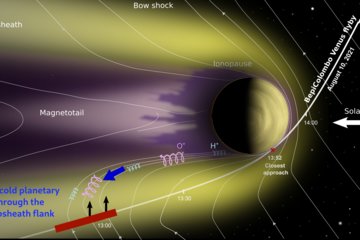All genres
41.
Journal Article
First observations of 140 MHz plasmaline backscatter during heating experiments at Tromsø. Journal Geophysical Research 89, pp. 11038 - 11042 (1984)
42.
Journal Article
Simultaneous observations of ELF waves from an artificially modulated electrojet in space and on the ground. Journal Geophysical Research 89, pp. 1655 - 1666 (1984)
43.
Journal Article
Frequency dependence of anomalous absorbation caused by high power radio waves. Journal of Atmospheric and Terrestrial Physics 46, pp. 147 - 153 (1984)
44.
Journal Article
Ionospheric heater beam scanning: A new technique for ELF studies of the auroral ionosphere. Radio Science 19, p. 1069 (1984)
45.
Journal Article
Raketenmessungen von Modifikationen des Ionosphärenplasmas der F-Schicht, erzeugt von der HEATING-Anlage in Nordnorwegen. KLeinheubacher Berichte (Kleinheubach, 3.-7.10.1983) 27 (1984)
46.
Journal Article
Stimulated electromagnetic emission: A new technique to study the parametric decay instability in the ionosphere. Journal Geophysical Research 89, pp. 7523 - 7536 (1984)
47.
Journal Article
Medium Frequency Radar Observations in the Middle Atmosphere. Journal of Atmospheric and Terrestrial Physics 45, pp. 729 - 732 (1983)
48.
Journal Article
Observations of enhanced plasma lines by EISCAT during heating experiments. Radio Science 18, pp. 861 - 866 (1983)
49.
Journal Article
Observations of HF backscatter associated with the heating experiment at Tromsø. Radio Science 18, pp. 840 - 850 (1983)
50.
Journal Article
Production of auroral zone E-region irregularities by ionospheric heating. Journal Geophysical Research 88, p. 6347 (1983)
51.
Journal Article
A hysteresis effect in the generation of fieldaligned irregularities by a high-power radio wave. Radio Science 18, pp. 835 - 839 (1983)
52.
Journal Article
Ionospheric elctric field pulsation: A comparison between VLF results from an ionospheric heating experiment and STARE. Journal Geophysical Research 88, p. 2140 (1983)
53.
Journal Article
Ionospheric elctric field pulsation: A comparison between ULF results from an ionospheric heating experiment and STARE. Radio Science 88, p. 2140 (1983)
54.
Journal Article
Summary of results obtained with the Tromsø heating facility. Radio Science 18, pp. 831 - 834 (1983)
55.
Journal Article
Observations of stimulated electromagnetic emissions in ionooospheric heating experiments. Radio Science 18, pp. 851 - 860 (1983)
56.
Journal Article
Observation of HF backscatter associated with the heating experiment at Tromsø. UIO-Report SR-82-02, p. 66 (1982)
57.
Journal Article
Phase changes induced in a diagnostic radio wave passing through a heated region of the auroral ionosphere. Journal Geophysical Research 87, pp. 1557 - 1564 (1982)
58.
Journal Article
Nonlinear reflectivity of high-power radio waves in the inosphere. Nature 295, p. 680 (1982)
59.
Journal Article
Wide band attention of radio waves caused by powerful HF waves: Saturation and dependence on ionospheric variability. Journal Geophysical Research 87, pp. 1551 - 1555 (1982)
60.
Journal Article
Ionospheric modification experiments in northern Scandinavia. Journal of Atmospheric and Terrestrial Physics 44, pp. 1025 - 1041 (1982)











